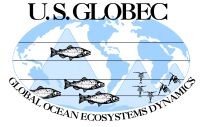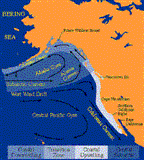
__________
GLOBEC
International
__________
| GLOBEC Northeast Pacific Program Mapping of Physical and Biological Fields in the Northern California Current July 31 - August 19, 2002 |
 |
|
Background What is GLOBEC? GLOBEC (GLOBal ocean ECosystems dynamics) is a coordinated research program that has been organized by oceanographers and fisheries scientists to study the effect global climate change may have on the abundance and production of animals in the sea. The U.S. GLOBEC program has research efforts located in the Georges Bank / Northwest Atlantic Region as well as the Northeast Pacific. The Northeast Pacific program studies components of the California Current and the Coastal Gulf of Alaska. U.S. GLOBEC is a contributor to GLOBEC international. The Northeast Pacific Program The GLOBEC studies in the Northeast Pacific focus on two areas: the California Current and the Coast Gulf of Alaska. The goals include mapping out the physical and biological oceanographic distributions and processes that influence juvenile salmonid habitat along the Oregon and northern California coast. The studies will also seek to understand how physical circulation features influence distributions of phytoplankton, zooplankton and larval fish. These circulation features can include upwelling fronts and jets and recirculation around submarine banks. The California Current runs north to south along the United States
coast. Winds blowing offshore in this area push water away from
the coast causing upwelling of colder, nutrient-rich water which
influence the productivity of
copepod,
euphausiid, and salmonid species. Northeast Pacific Program Summary U.S. GLOBEC Reports (pdf files)
|
This page was last updated on August 17, 2002 08:13 AM


